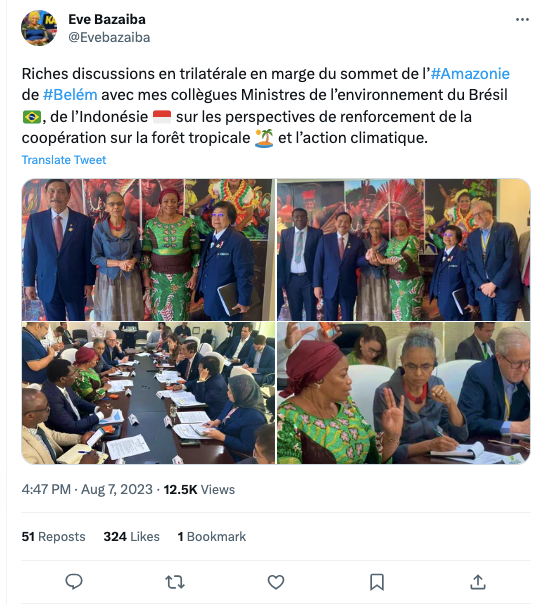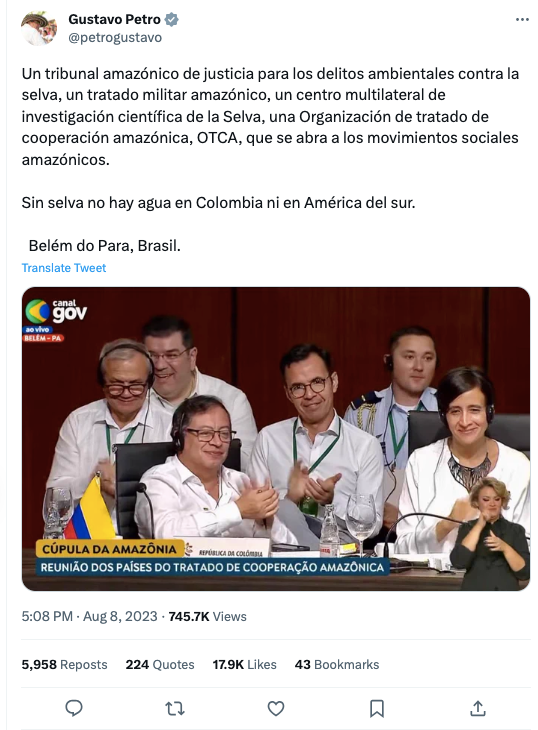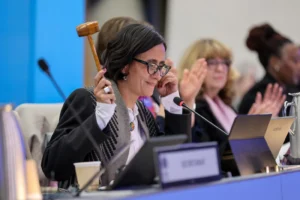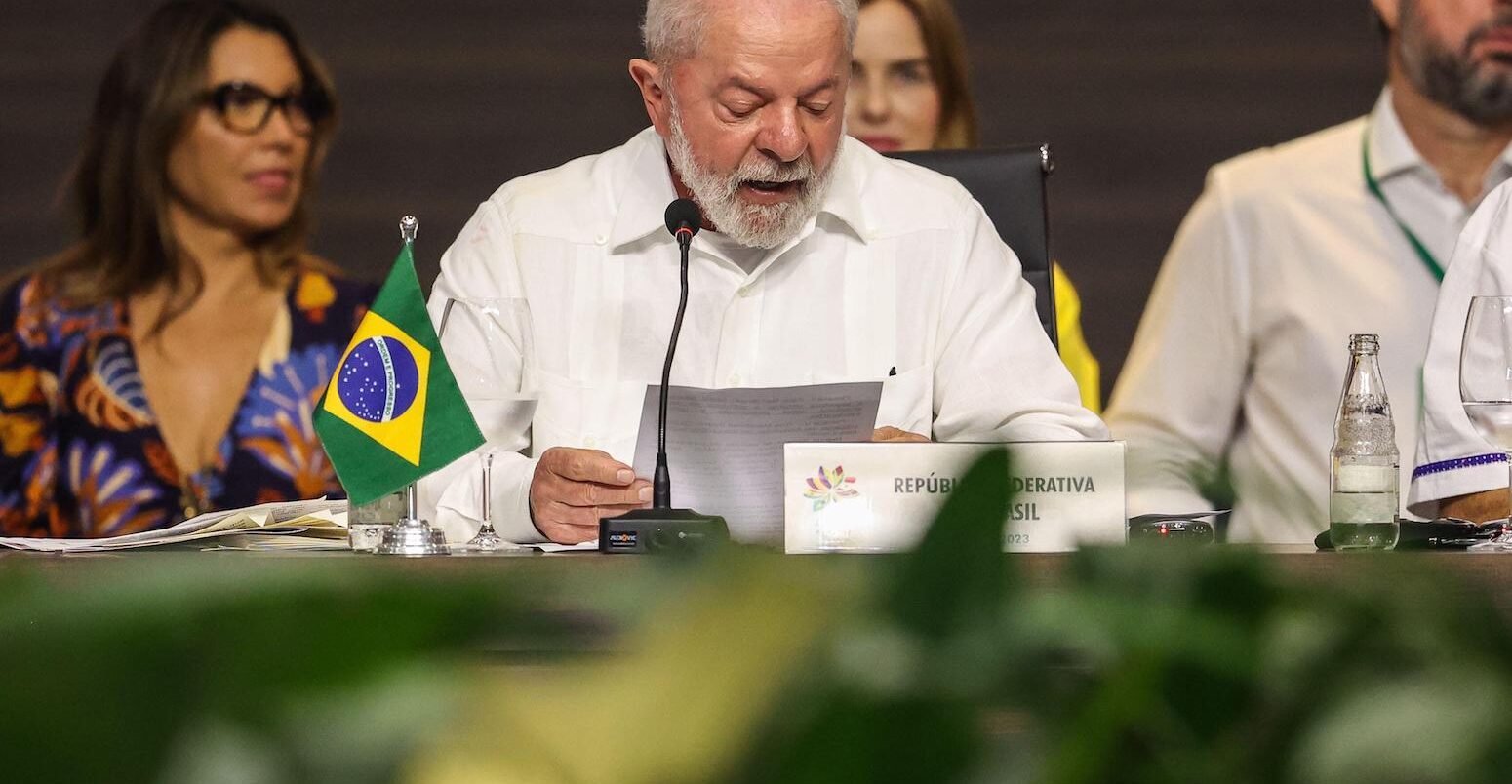
Q&A: What the Amazon Summit means for deforestation and climate change
Multiple Authors
08.11.23Multiple Authors
11.08.2023 | 12:45pmLeaders of the eight Amazon basin countries committed this week to act together to prevent the rainforest “from reaching the point of no return” – although they stopped short of agreeing upon a common target for ending deforestation.
At a meeting in Belém, Brazil, on 8-9 August, heads of state and foreign ministers gathered to discuss how to take a cooperative approach to a range of issues, including forest protection, climate change, Indigenous rights and cross-border crime.
Among the headline statements of the so-called Belém Declaration were a recognition that the Amazon is approaching a “tipping point”, a call for developed nations to fulfil their existing pledges for climate and biodiversity finance, and a pledge to protect the rights and territories of Indigenous peoples.
Leaders from several other rainforest nations joined the summit on the second day, producing a second declaration, called “United for Our Forests”, which largely echoed the first declaration’s concerns on non-fulfilment of funding obligations.
But two notable omissions from the declaration were a region-wide commitment to ending deforestation by 2030 and to halting oil and gas expansion, two issues that were being closely watched in the leadup to the summit.
And several Indigenous leaders told Carbon Brief that the lack of specific targets and concrete actions have left them worried about the declaration’s implementation.
In this article, Carbon Brief lays out the key takeaways from the summit – and reactions from a range of experts.
- What is the ‘Amazon Summit’?
- What were the main outcomes of the summit?
- What is the goal to protect 80% of the Amazon by 2025?
- What was the reaction to the summit’s outcomes?
What is the ‘Amazon Summit’?
The Amazon Summit gathered the eight members of the Amazon Cooperation Treaty Organization (ACTO) for just the fourth time in the group’s history – the last time being in 2009, during the first term of Brazilian president Luiz Inácio Lula da Silva (Lula). Convening the summit once more was one of Lula’s pledges during last year’s campaign.
Among the attendees this time were the presidents of Brazil, Bolivia, Colombia and Peru, the vice-president of Venezuela, the prime minister of Guyana and ministers from Ecuador and Suriname.
The summit was designed to “define the regional agenda in favour of the sustainable development of the Amazon biome”, according to ACTO. It took place in Belém, often called the “gateway to the Amazon”. Belém is the capital of the north-eastern Brazilian state of Pará, which is a deforestation hotspot.
Ahead of the meeting, more than 50 environmental groups had signed a Climate Observatory petition calling on the assembled leaders to commit to a plan “to stop the Amazon from reaching a point of no return”.
Last week, Lula told the press:
“I have high expectations for this summit. For the first time we are going to have a common policy for the Amazon, for preservation, security [and] borders.”
The summit was preceded by the summit “dialogues”, which brought together Indigenous peoples, activists, academics, civil-society organisations, thinktanks and representatives of government agencies from across the region. The outcomes and recommendations from these dialogues were presented to the heads of state at the summit. The Amazon Technical-Scientific Meeting, held in Leticia, Colombia in early July, also served as a precursor to the summit.
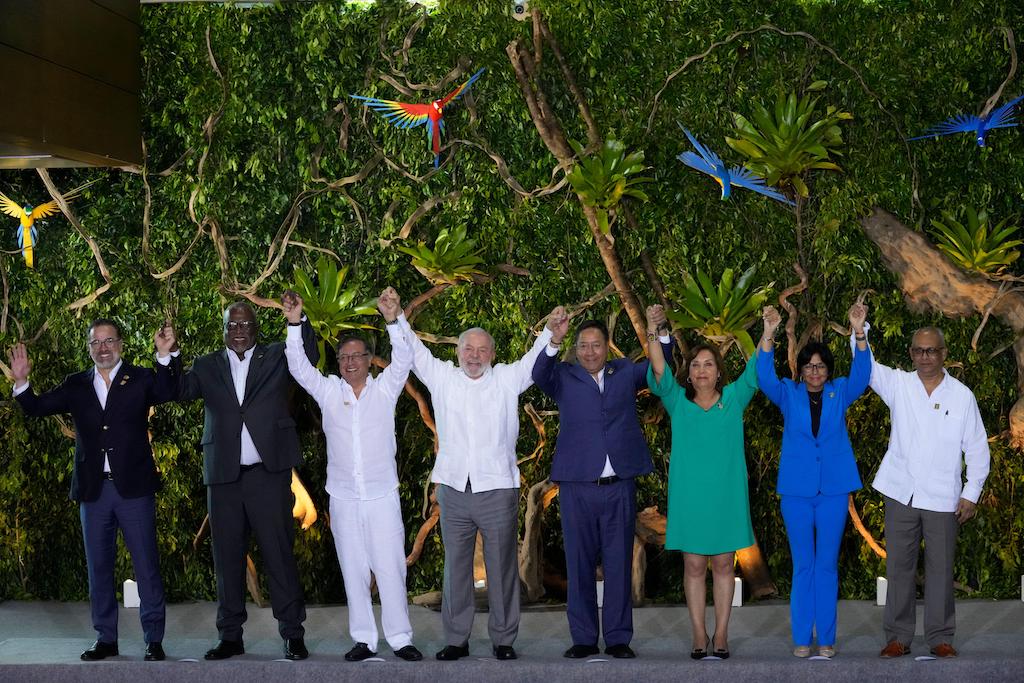
The summit also brought together representatives from the Democratic Republic of the Congo, the Republic of the Congo and Indonesia – themselves each home to a sizable fraction of the world’s tropical rainforests.
On the second day of the summit, those three countries, the eight Amazon nations and the Caribbean nation of Saint Vincent and the Grenadines issued a joint statement calling upon developed nations to fulfil their climate finance and mitigation targets. The statement also invited other “developing countries with tropical forests to engage…in a dialogue, based on solidarity and cooperation” ahead of the COP28 climate summit in Dubai later this year.
Norway and Germany, as major donors to Brazil’s Amazon Fund, were also in attendance, as was the French ambassador to Brazil, representing the territory of French Guiana, which also contains a portion of the rainforest.
Dr Patricia Pinho, the deputy science director at the Amazon Environmental Research Institute (IPAM), tells Carbon Brief that the declaration will be useful for COP28. It further sets in place the “pathway to COP” in 2025, which is due to take place in Belém, Pinho says, adding:
“Most of this discussion I don’t think is going to go away soon, as we have this path towards [the] Belém COP.”
What were the main outcomes of the summit?
The Belém Declaration, issued after the eight countries’ representatives met on Tuesday, sets out five “cross-cutting principles” for carrying out its implementation: active participation of Indigenous peoples; protecting human rights; gender equality; recognition and respect of the region’s cultural diversity; and the sovereignty of each individual country.
The text holds more than 100 decisions, ranging from the establishment of new scientific bodies to a call for increased funding. Climate change features heavily across the text.
Prof David Lapola, an ecologist at the State University of Campinas in Brazil, tells Carbon Brief:
“We are always expecting more than these big summits tend to deliver for us in terms of concrete measures or actions…Putting together the Amazonian countries to think on their key problems together, this is an advancement already.
“If we can keep the momentum [going] then the meeting will have been very valid.”
Deforestation target
One of the Brazilian president’s major goals for the Amazon summit was to get closer to a unified target to end Amazon deforestation by 2030.
Lula said this would help lead the region towards a new “Amazon dream”, the Guardian reported, with “greener cities” and “cleaner air”.
Brazil, which holds 60% of the Amazon basin, has already adopted this position, alongside more than 100 other countries. Bolivia and Venezuela are the only Amazon countries that have not signed this global pact, Reuters reported.
However, despite this aim, the Amazon summit ended with no specific deforestation target in place.
The declaration focused on increasing cooperation in facing a range of challenges, including deforestation, and emphasised the “urgency” of agreeing common goals by 2030. It says this action will lead towards the “ideal of reaching zero deforestation” in the region, but the text does not mention a target date for achieving this goal.
The eight Amazon countries agreed to work together against forest destruction, with nations able to pursue their own individual deforestation goals. The declaration also stated that it is important for countries to work better to prevent the region from “reaching the point of no return”.
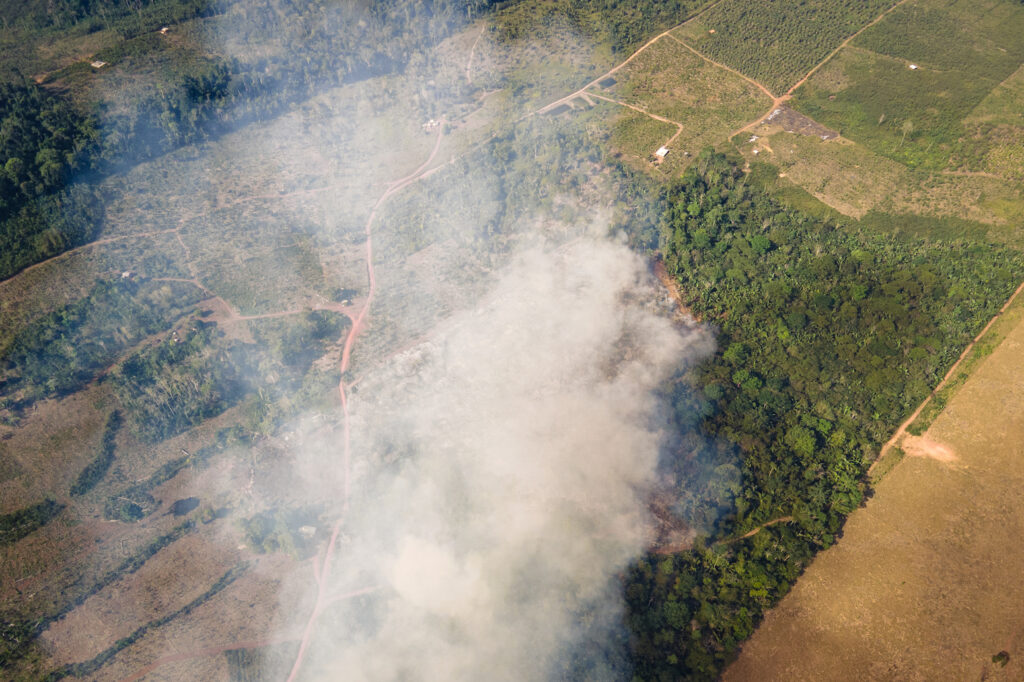
Scientists have long warned that climate change and human-driven deforestation could push the Amazon rainforest past a “tipping point” – a threshold beyond which a small change could push a system into a completely new state.
If the Amazon reached this point, it would see the dieback of large sections of lush rainforest and a shift to dry grasslands. However, modelling studies have been unable to agree on if and when this threshold might be crossed.
Pinho noted that the Amazon “is going to be severely impacted by increasing global warming temperatures”, citing the Intergovernmental Panel on Climate Change (IPCC).
It is “frustrating” that countries did not agree on a specific deforestation target, Pinho tells Carbon Brief, but she said she believes the summit will help tackle forest loss. She adds:
“It’s not only about deforestation, but also discussing forest degradation and how to tackle those issues that are associated with local drivers – logging, fire and development projects and so on.
“In that regard, those countries can demand more strong actions from developed nations to support adaptation and mitigation actions under this climate crisis, so no one can be left behind on those resilient pathways.”
Lapola echoes the sentiment that halting deforestation is not sufficient to protect the forest. He tells Carbon Brief:
“Even if we stop deforestation, the forest will still be vulnerable to climate change, which can alone cause the tipping point in the region if we have severe climate change, regardless of deforestation. So we could have called the attention of the world to this as well.”
A press release from Avaaz criticised the lack of a common goal “to protect the rainforest”.
Diego Casaes, campaign director at Avaaz, said that the declaration “casts serious doubt over the region’s leaders’ willingness” to protect the Amazon. He said in a statement:
“Instead the declaration kicks the can down the road. The Amazon tipping point is here and now, we cannot delay.”
Finance
Finance always plays a significant role in discussions around climate change and biodiversity loss.
Lula said that developed nations need to follow through with pledges to fund forest protection. According to the Associated Press, he said:
“Nature, which industrial development polluted for 200 years, needs them to pay their part so we can revive part of what was ruined. Nature is in need of money.”
Developing countries will need significant financing over the coming years to invest in low-carbon energy and defences against climate threats, as Carbon Brief has previously reported.
A joint statement issued by Amazon and other rainforest nations’ leaders at the summit called on wealthier countries to meet their climate finance commitments.
In the Belém declaration, countries agreed to combine efforts to build a fund for programmes promoting sustainable management and adding value to forest products and biodiversity. This would also be used for people involved in activities that benefit the environment, with a specific mention of the “active participation of Indigenous peoples and local communities”.
The declaration further underscored the “urgent need to scale up climate action” and agreed to advance “innovative” ways of financing climate action, which could include debt-for-climate swaps.
Karla Maas, senior advisor at Climate Action Network (CAN) Latin America, tells Carbon Brief that countries should not rely on external resources and international solidarity to fund programmes and actions to conserve the rainforest. Instead, she recommended implementing a fossil fuel tax at a global level, along with other global funding schemes.
Oil and gas exploration
The Belém Declaration says it will “initiate a dialogue” among the Amazon countries as to the sustainability of oil and gas exploitation and mining in the region.
It also seeks to identify new electricity generation projects and explore clean energy models, with the goal of promoting energy access and security, along with sustainable development.
The declaration calls for the “eradication” of illegal mining, and emphasises the need for “effective cooperation” to combat species and product trafficking.
Belén Páez, director of Fundación Pachamama – a non-governmental organisation that works with Amazonian communities to conserve biodiversity – noted that the Belém Declaration did not reach an agreement on addressing oil exploitation in the region, despite “intense discussions” by civil society groups. She tells Carbon Brief:
“The importance of kicking off dialogues to address how oil and mining extractive sectors would become sustainable was barely mentioned.”
Ecuador is holding a referendum later this month on whether or not to leave fossil fuels unexploited in the Yasuní National Park.
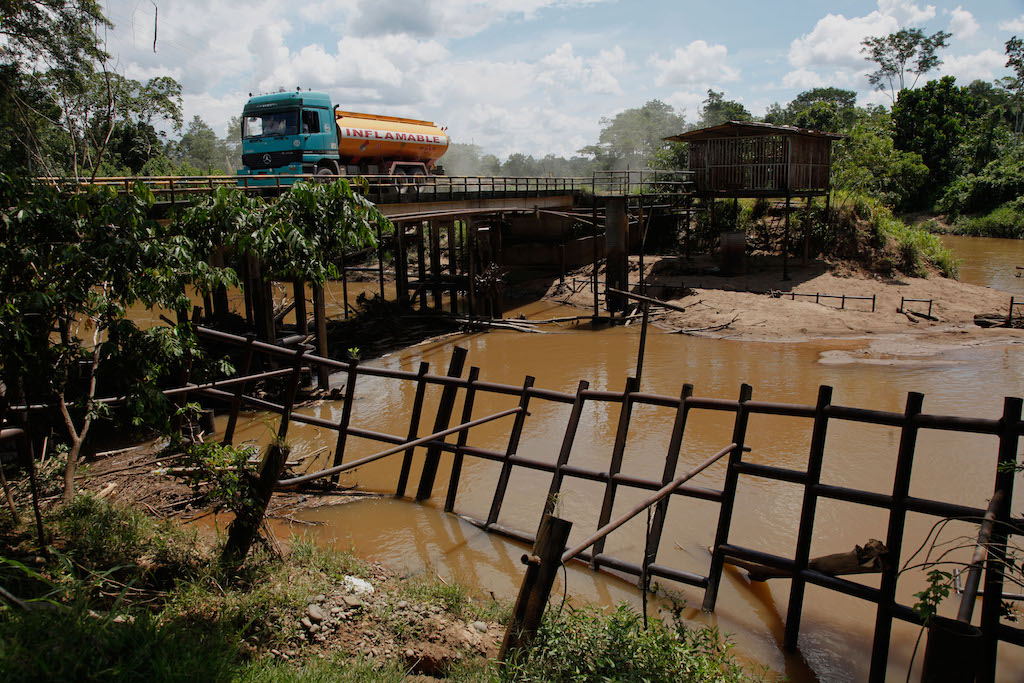
Páez says:
“The small Amazonian country is telling the world that democratisation towards climate policies, social justice and decarbonisation of economies is possible.”
Politico reported that Colombian president Gustavo Petro argued the need for “an ambitious transnational policy to phase out fossil fuels” to avoid the point of no return of the Amazon rainforest.
Many civil and Indigenous organisations described the talks as “hopeful but insufficient” due to the lack of specific commitments related to oil and gas production in the region, according to a press release from the Fossil Fuel Non-Proliferation Treaty Initiative.
The group also recommended that ACTO undertake dialogues with Indigenous peoples and highlighted the need to halt oil exploitation in rich and middle-income countries, including Brazil.
In the press release, Alex Rafalowicz, director of the Fossil Fuel Non-Proliferation Treaty Initiative, said that countries committing only to initiating a dialogue is “not nearly enough”. He called on the nations of the Amazon to take “effective and concrete actions” to halt the proliferation of oil and gas exploitation in the world’s largest rainforest.
Sustainable development
How to achieve sustainable development was one of the overarching questions at the summit.
The declaration says it will “provide firm support” for strengthening ACTO as an instrument for sustainable development in the Amazon. It highlights south-south cooperation and international funding as two key ways to build capacity in the region.
Some strategies listed in the document include promoting climate-change adaptation programmes through external, non-reimbursable financing, cooperating with scientists to guide climate policies related to the restoration of native vegetation, sustainable environmental management, and promoting sustainable production and consumption.
The declaration says that agroforestry systems and sustainable forest management will be boosted, and they will examine the possibility of establishing a Joint Amazon Mechanism of Mitigation and Adaptation for Integrated and Sustainable Forest Management to help implement Article 6.8 of the Paris Agreement, which relates to “non-market” approaches.
The eight nations’ commitments to a range of international treaties and objectives, including the UN Sustainable Development Goals (SDGs) and the Paris Agreement, are reaffirmed in the preamble. The declaration also establishes the Forum of Amazon Cities, which will fall under ACTO and aim to implement the SDGs at local levels.
The newly created Intergovernmental Scientific Technical Panel for the Amazon (see “IPCC for the Amazon”) will also be used to “promote sustainable development”, the declaration says.
ACTO also condemned “unilateral trade measures based on environmental requirements and norms”, saying that such measures impede sustainable development and primarily affect smallholder farmers. This language was a “thinly-veiled…condemnation” of the EU’s recent deforestation legislation, which prevents the import of goods linked to deforestation, Climate Home News wrote.
Colombian president Gustavo Petro has previously proposed creating a fund that will support farmers who are currently contributing to deforestation, helping to “compensate them for conservation and regenerative activities instead”, according to the Associated Press.
Indigenous rights
The Belém Declaration says that the active participation of Indigenous peoples and local communities and respecting of their rights are crucial to advance a new common agenda for the Amazon.
It also establishes the Amazon Mechanism for Indigenous Peoples to “strengthen and promote dialogue between governments and Indigenous peoples in the Amazon region” – a formal way for Indigenous peoples to participate in ACTO.
Fany Kuiru, general coordinator of the Coordinator of Indigenous Organizations of the Amazon River Basin (COICA) and a Colombian Indigenous leader, tells Carbon Brief that the Belém declaration included Indigenous peoples throughout the text – for instance, by establishing that mechanism.
COICA stretches across nine countries, accounting for 511 Indigenous groups. Kuiru attended both the Amazon Summit and the scientific and technical meeting in Leticia in July.
She tells Carbon Brief that the Belém Declaration contains reference to legal security for Indigenous territories, including the titling and demarcating of their lands – a key ask from Indigenous representatives. However, she adds, there are no clear commitments or concrete actions in the short or medium term, “which has disturbed the Indigenous brothers and sisters of COICA”.
Auricélia Arapiuns, coordinator of the Tapajós and Arapiuns Indigenous Council, mentioned in a briefing that Indigenous peoples expected announcements of specific targets for land demarcation and other concrete actions, but they were not included in the declaration. “The divergences have been worrying,” she said.
The Assembly of the Peoples of the Earth for the Amazon sent a letter to the representatives of the states attending the Amazonian dialogues and the Amazon Summit. In it, Indigenous peoples called for a range of actions, such as the safeguarding of their territorial rights – including demarcation and titling of their lands by 2025 to continue conserving the rainforest – and accounting for international Indigenous rights frameworks, such as the UN Declaration on the Rights of Indigenous Peoples, in national policies.
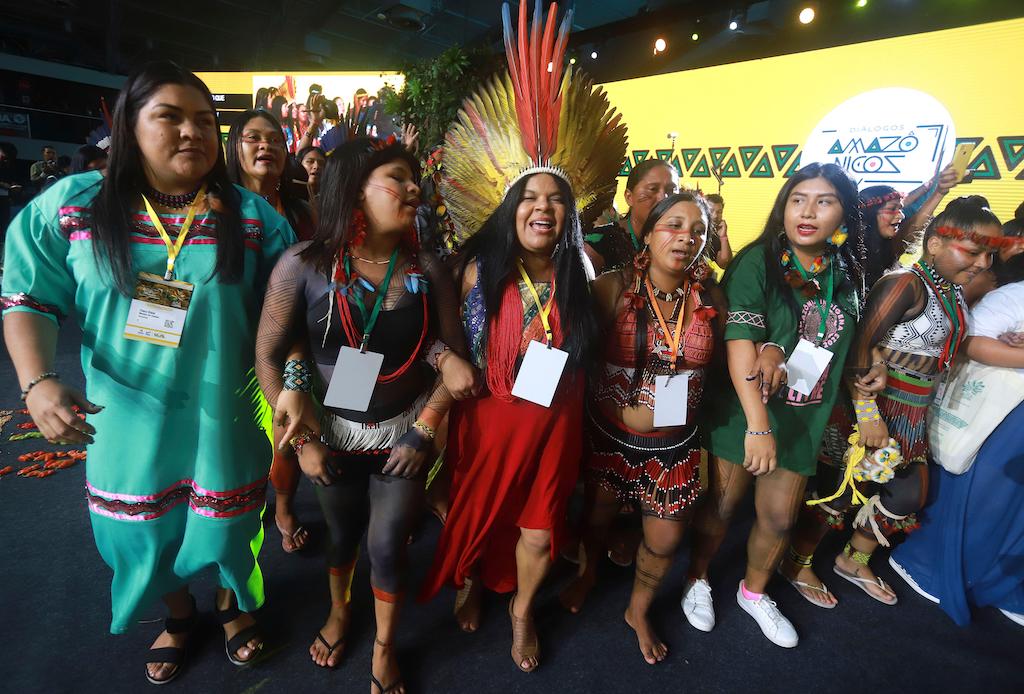
Other requests included the “effective implementation” of mechanisms for the participation of Indigenous peoples in processes such as carbon markets and the creation of zones free from oil exploration, including Yasuní National Park in Ecuador and the Amazon River in Brazil’s Amapá state, where the Brazilian state-run oil company Petrobras is seeking to drill an exploratory well.
Kuiru tells Carbon Brief:
“If governments do not work hand in hand with Indigenous peoples, local communities and other sectors that live in the Amazon, we will not be able to materialise the declaration into real actions.”
‘IPCC for the Amazon’
The declaration calls for the establishment of an Intergovernmental Scientific Technical Panel for the Amazon, termed the “IPCC for the Amazon” by several news outlets.
According to the declaration, the panel is to be convened annually, with a wide range of participants including “technicians, scientists and researchers specialised in the Amazon region, with the permanent participation of civil society organisations, Indigenous peoples and local and traditional communities”.
It calls for “periodic reports” from the panel that can help inform government actions around environmental protection and sustainable development.
Lapola tells Carbon Brief that he is “not surprised” by the establishment of the new panel, but pointed out that a seemingly similar body already exists – the Scientific Panel for the Amazon (SPA), convened under the UN Sustainable Development Solutions Network. The SPA issued a first assessment report on the Amazon in 2021. It is unclear, Lapola notes, whether or how the new body will differ from the SPA.
Food, health and nutrition
In several sections, the declaration laid out actions for addressing food security, nutrition and health needs of the region, including by “reviving” ACTO’s special commission on health (along with several other commissions).
Under actions for water-resources management, the declaration called for “coordinated actions to guarantee the human right to drinking water and sanitation”. It further pressed for the creation and harmonisation of early-warning systems that can help mitigate the impacts of extreme weather events.
It also called on ACTO members to promote universal health care – something that the World Health Organization has said is “inextricably linked” to climate change and the environment. It emphasised the need for mitigating pandemic threats and the emergence of new tropical diseases and “those associated with the impacts of climate change”.
Separately, the declaration stated the need for coordinated actions on nutrition and food security and sovereignty, “favouring traditional, family and community production systems”.
Combating crime
Tackling crime in the Amazon was another key part of the summit.
The Brazilian government’s drug policy chief said there is an “urgent” drug-trafficking situation in the Amazon, the Guardian reported recently.
And, according to a Mongabay comment piece by researchers at the Igarapé Institute, a Brazilian environmental thinktank, environmental crimes such as illegal logging and gold mining are “razing the Amazon Basin at a breakneck pace”.
Overall, the final declaration did not set specific targets or timeframes for cutting crime.
It instead committed to strengthening regional and international cooperation in the “fight” against illegal mining, illegal trade and other crimes. Countries also agreed to bolster police cooperation to tackle illegal activities, including environmental crimes.
It emphasised the need for countries to work together to combat the illegal trafficking of Amazonian species and products. The declaration also mentioned developing more cooperation in preventing, investigating and prosecuting crime leading to deforestation and biodiversity loss in the Amazon.
What is the goal to protect 80% of the Amazon by 2025?
Activists have been pushing for a goal to protect 80% of the Amazon by 2025.
The ”80×25” initiative is described as an “urgent measure to avert an imminent tipping point” in the rainforest. The goal, led by COICA, is supported by more than 1,200 organisations and global leaders.
It is “still possible” to achieve the goal by 2025, according to a 2022 report released by COICA, but it will require “urgent measures to safeguard” the rainforest.
Campaigners and governments backed calls from Indigenous peoples to follow this goal at the world congress of the International Union for the Conservation of Nature in 2021. In total, 61 countries voted in favour of a global pact to protect the Amazon forest at that meeting.
A few days before the Amazon summit, Colombia publicly backed the 80×25 goal. The country’s minister of environment and sustainable development, Susana Muhamad, said this goal must be integrated into the declaration at the summit.
However, a clear unified goal, “such as the protection of 80% of the forest to avoid the tipping point, is absent” from the Belem declaration, Avaaz’s Casaes noted in a press statement.
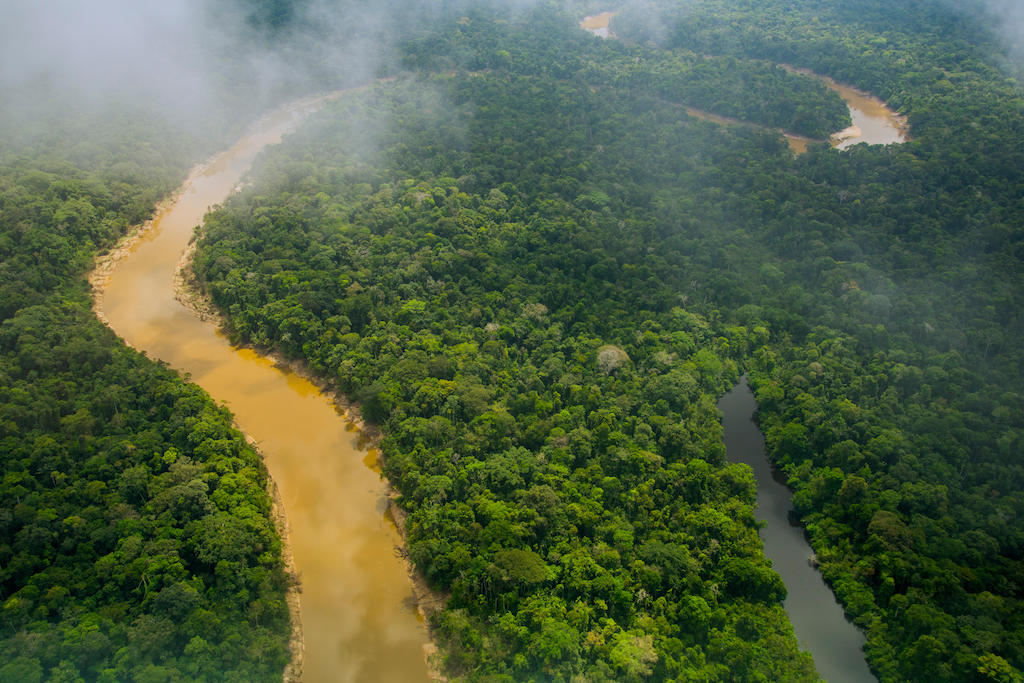
Rather than a specific, unified goal to end deforestation across the Amazon, the declaration highlights the importance of cooperation in tackling challenges in the Amazon region, especially those related to climate change, biodiversity loss and other issues.
The declaration also notes the “key role played by Indigenous populations and local and traditional communities in conserving the biodiversity and natural resources in the region”.
The recognition of the rights of Indigenous peoples in the Amazon basin is an “urgent solution” to reach the 80×25 goal, José Gregorio Díaz Mirabal, the general coordinator of COICA, said at COP27 in Sharm el-Sheikh in November last year. He added:
“We must act together, and we must do it before 2025. Anything less would be too little too late. We have entered the danger zone.”
Lapola notes that in the Brazilian Amazon, more than 50% of the forest is “already protected”. He continues:
“So it wouldn’t be a big effort to protect a bit more to reach that target. But bear in mind that conservation also has different meanings. I’m not sure it will be possible to protect everything, all this 80% without any human action happening inside these areas.
“The real protection we want in the Amazon will come only when we conquer people’s hearts and minds about the importance of the forest…In that sense, we wouldn’t need to a top-down policy protecting 80% – or even more – of the Amazon if we had people understanding the importance of the forest and how their lives are better with the forest.”
What was the reaction to the summit’s outcomes?
Scientists, policy experts and campaigners have pointed out several weaknesses in the Belém Declaration and the summit itself, mainly around the absence of clear commitments to halt deforestation in the region.
Pinho says that while many shortcomings of the declaration are “frustrating”, the summit brought together “many different stakeholders at the same table”. She tells Carbon Brief:
“[Although] the leaders didn’t agree a very strong commitment with numbers and percentages and timeline of the action…We need to remember this, how hard it is to place these leaders together. So geopolitically, this is very important.”
Lapola echoed the sentiment, telling Carbon Brief:
“Of course, there was an expectation of having zero deforestation targets agreed by everyone…but this is something that can be constructed in the next years, if we have a good network among or between these countries.”
He highlights four ways that the declaration “could have been stronger”: establishing a common deforestation target, stronger language on oil exploration, stronger recognition of the forest’s vulnerability to climate change and establishing a roadmap towards building an economy “based on the standing forest”.
Kuiru, the Colombian Indigenous leader, tells Carbon Brief:
“It’s an achievement for Indigenous peoples participation, with their own spaces for [dialogue], although in the whole document [there is not] a concrete way [to carry out the] activities. [We hope] to continue with the dialogue with governments, civil society, to make public policies.”
Kuiru says that the Colombian environment minister, Susana Muhamad, “wants to continue exploring” how to achieve the 80×25 goal.
Muhamad also stressed that “ACTO cannot be a ‘closed diplomatic body’” and called for the participation of all people, social movements and Amazon inhabitants in such an organisation, the Colombian outlet El Espectador reported.
Adriana Lobo, the managing director of global presence and country action at the World Resources Institute, said in a statement:
“The summit left us with great hope that Amazon countries are coming together for a better path for the forest and its inhabitants, driving a global movement for a more sustainable economy…Now Amazon countries need to put these ideas into practice – creating a plan with specific actions, public policies and time frames. And a strategy for attracting the investments needed to make this a reality”.
The summit “was a missed opportunity for the region to establish cooperation and a joint message”, Caroline Prolo, the director of Latin American Climate Lawyers Initiative for Mobilizing Action and an advisor at the International Institute for Environment and Development, said in a statement.
Prolo pointed out that Latin America has historically been a “fragmented” political bloc in UNFCCC negotiations.
But Kuiru is more positive about the cooperation established at the summit. He tells Carbon Brief:
“[The declaration] is going to be a navigation route to bring the voices of the countries of the Amazon Basin to the COP28. I believe that there are valuable elements here that the governments of the eight countries should deliver to the COP.”
Maas tells Carbon Brief that although expectations were high going into the summit, the declaration “is still a political document”.
She notes the absence of specific goals in the declaration and the “substantial differences” in countries’ stances, adding:
“It is very hard when governments are not in line with the same goals.”
For Maas, this summit revealed that it is not only the OPEC countries, but the Amazon countries as well, who are not willing to leave fossil fuels unexploited. She points out that the language used in the declaration does not mention the term “fossil fuel phase out”, instead containing less clear language “initiat[ing] a dialogue” on the sustainability of the fossil fuel sector.
Ultimately, Brazil’s leadership at the summit was significant, Pinho says, telling Carbon Brief:
“We have distinct countries sharing the Amazon, we have different governments in place. But given that the majority of the Amazon forest lies in the Brazilian territory, the dynamics that we see here really disseminate throughout the region.”
She says discussions at the summit also focused on how “if we keep the current marginalisation of vulnerable populations or Indigenous peoples and traditional population”, it will lead to further environmental degradation and biodiversity loss.
“[The] climate crisis…is becoming now what I call a humanitarian crisis in the Amazon biome,” she adds.


